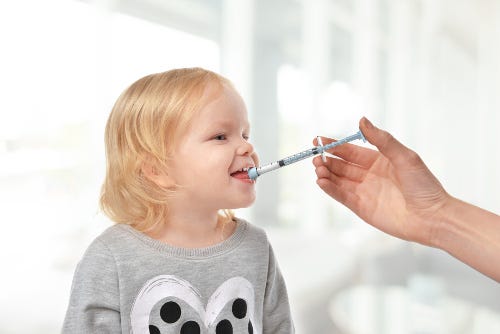May 23, 2017
HS Design's Michael Quinn explains how his team used a familiar form factor and other design elements to make it easier to get kids to take their medicine.
Jamie Hartford

HS Design won a $50,000 grant from Pfizer and the Institute of
Pediatric Innovation for its Sympfiny design.
As any parent knows, getting kids to take their medicine can be a struggle. In fact, the average compliance rate in children is only around 58%, according to one study. The problem--as any kindergartener will tell you--is that medicine often tastes pretty gross. But while Mary Poppins proposed a spoonful of sugar to help the medicine go down, these days there's a much more high-tech approach.
Multiparticulate drug formulations deliver medicine not in liquid form but rather as solid microspheres surrounded by a coating that dissolves in the stomach. That saves kids from experiencing the icky taste, but it also creates a few new challenges. If the drug particles get damp or statically charged, they can stick together. When they're dry, they can easily escape through small openings because they don't have surface tension like a liquid. That can all lead to inaccurate dosing when the drug is delivered via a satchel or pack.
Gladstone, NJ-based design firm HS Design--which you can see at MD&M East booth #1470 June 13-15, 2017--set out to find a better delivery solution that would work for patients, caregivers, and drug makers. They came up with Sympfiny, a drug-delivery device that uses the same technique used for liquid oral drugs and applies it to multiparticulate, dry powder, and microsphere formulations.
Here, in his own words, Michael Quinn, director of engineering at HS Design, explained some of the design decisions that made Sympfiny possible:
'Syringe and Bottle' Format
The HSD team explored dozens of ways medication could be dosed and delivered to children. In the end, the decision to model the system after the familiar syringe and bottle came down to the control that a syringe gives the caregiver. One of the most challenging aspects of delivering medication to a child is simply getting it into their mouth. The syringe form factor is small, familiar, and requires only one hand to control.
Valve at the Syringe Tip
The main challenge of the syringe was controlling the multiparticulate at the opening. Unlike liquids, the microspheres have no surface tension and will pour out of the smallest opening. To solve this problem, we engineered a valve at the tip of the syringe. It is resilient enough to prevent drug from leaking out of the tip but flexible enough to open when the plunger is depressed. This gives precise control to the caregiver and allows them to start and stop dispensing at will.
Dose-Control Plunger Rod
The Sympfiny syringe has a unique plunger rod that allows precise dose control. The plunger has grooves into which a clip can be placed to control how far the plunger can be pulled back relative to the syringe barrel. This gives the caregiver an easy way to fill the syringe to a given dose. From our experience, we know that the biggest variable to dose accuracy is the position of the plunger rod when drawing a dose. By making a dose-control plunger rod, we take that variable away and help reduce anxiety over the preparation step.
Plunger Head
The plunger head is a separate component that snaps onto the plunger rod. It is made of plastic rather than rubber and is black in color. We chose this configuration for three reasons. The first was to eliminate silicone oil; rubber stoppers require oils to glide properly while plastic seals do not. Multiparticulate would stick to an oily surface. The head is colored black so it is visible against the mostly white multiparticulate drugs. Lastly, we separated the head so that the plunger rod can be quickly customized without needing to re-validate a drug contact component. Customizations can involve adding laser marking fillers to the plunger rod or changing the dose increments.
In addition to the syringe tip valve, the bottle also has a valve. The bottle valve is activated only when a syringe is attached and closes instantly upon removal of the syringe. This allows the user to attach and detach the syringe in any orientation without risk of spilling. It also ensures the drug in the bottle is protected from environmental effects such as dust and humidity.
Jamie Hartford is director of content for medtech brands in UBM's Advanced Manufacturing Group. Reach her at [email protected].
[Image courtesy of HS DESIGN]
About the Author(s)
You May Also Like


